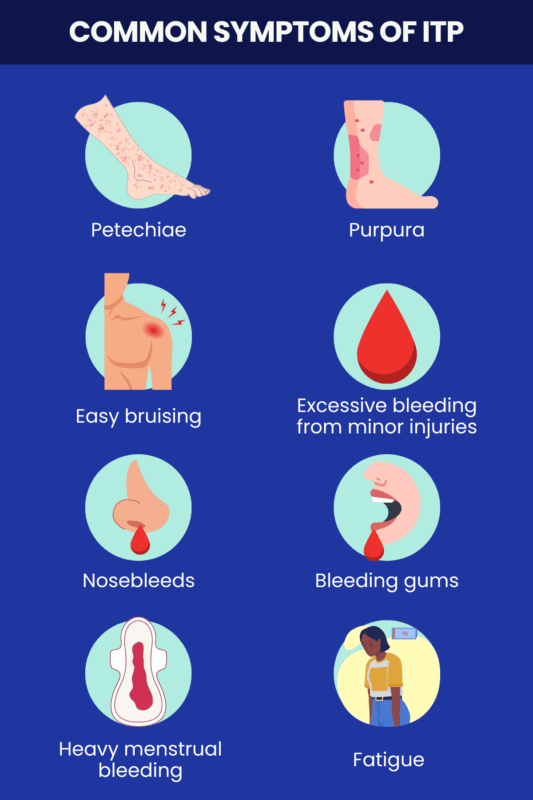Immune thrombocytopenia symptoms
Last updated June 23, 2025, by Lindsey Shapiro, PhD

The main symptoms of immune thrombocytopenia (ITP), including various forms of internal or external bleeding, arise from a lack of platelets — the cell fragments that are involved in blood clotting.
People with ITP are deficient in platelets because their immune system erroneously attacks and kills them. The body can manage a decline in the number of platelets to a certain extent, so the disease doesn’t always cause symptoms. But if platelet counts get low enough, patients may start to notice signs of bleeding, such as bruises, the appearance of red or purple spots on the skin, bleeding from the gums or nose, and fatigue.
More rarely, other more serious internal bleeding complications can also occur. Spotting the signs of ITP early on is important for making sure the disease is properly monitored and treated before further complications arise.
Common symptoms of ITP
The main ITP signs and symptoms are directly related to an increased risk of external or internal bleeding due to low platelet counts.
- If platelet counts are high enough that the risk of significant bleeding is avoided, there may not be any ITP symptoms.
- As platelet counts start to drop, a person may notice they bleed more easily or for longer after an injury or medical procedure.
- Very low platelet counts could cause bleeding to happen spontaneously even if no injury has occurred.
Some of the most common symptoms of ITP arise from bleeding under the skin:
- easy or excessive bruising
- petechiae, tiny red, purple, or brown spots on the skin that can look like a rash
- purpura, or larger red, purple, or brown patches on the skin
- hematoma, a collection of clotted blood under the skin that can look like a lump.
Petechiae and purpura are generally not tender or painful and can occur without a known trauma or injury. Besides appearing on the skin, petechiae and purpura can also form in mucus membranes, particularly inside of the mouth.
Other common bleeding symptoms that ITP triggers include:
- easy or excessive bleeding, even after a minor injury
- bleeding from the gums or blood blisters inside the mouth
- frequent or difficult-to-stop nosebleeds
- unusually heavy or prolonged menstrual bleeding.
In addition to these low platelet symptoms, people with ITP may also feel extreme tiredness or fatigue. Rather than being directly related to low platelet counts, this could be related to anemia — a lack of healthy red blood cells — due to excessive bleeding, or from other underlying conditions.

Less common but serious symptoms
While many symptoms of ITP are not serious, very low platelet counts can increase the risk of serious bleeding, including internal bleeding in vital organs. Uncommon but serious ITP symptoms may include:
- blood in the urine, stool, or vomit, which can be a sign of internal bleeding in the urinary or digestive tract
- severe or persistent abdominal pain, which can suggest abdominal bleeding
- neurological symptoms suggestive of bleeding in the brain, such as severe or persistent headaches, new or worsening confusion, dizziness or lightheadedness, blurred vision, weakness, and unexplained drowsiness.
Immediate medical care should be sought if these symptoms occur or if a person experiences any bleeding that’s prolonged or cannot be stopped with typical first-aid techniques. Brain bleeding is very rare, but can be fatal, so medical attention is also necessary after any head trauma, even without obvious symptoms.
How symptoms vary between children and adults
ITP causes excessive bleeding in both children and adults, and the main symptoms are generally the same. However, the severity and presentation of the disease can look different in these two groups.
- ITP in children, especially young children, is more often acute, with symptoms that appear suddenly but resolve on their own within about six months. These acute ITP symptoms are often triggered by an infection.
- ITP in adults is more likely to be persistent or chronic, with symptoms that last six months to a year or longer, and that require ongoing ITP treatment.
Studies have found that bleeding symptoms at diagnosis and the incidence of severe bleeding are more likely in children. On the other hand, bleeding into the brain is consistently found to occur more often in adults.
Because of these differences, ITP treatment and management can differ in children and adults.
Bleeding Disorders News is strictly a news and information website about the disease. It does not provide medical advice, diagnosis, or treatment. This content is not intended to be a substitute for professional medical advice, diagnosis, or treatment. Always seek the advice of your physician or other qualified health provider with any questions you may have regarding a medical condition. Never disregard professional medical advice or delay in seeking it because of something you have read on this website.
Recent Posts
- Bleeding risk high soon after kidney transplant in VWD, hemophilia A
- Combined therapy aids recovery for woman with TTP and lupus
- An ITP diagnosis wasn’t the final word on my health setbacks
- Cell therapy QT-019B shows strong response rate in hard-to-treat ITP
- Novel approach clears large, painful bleed in woman with VWD
